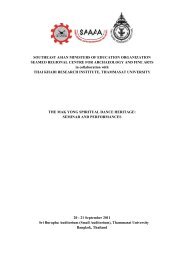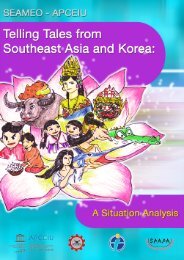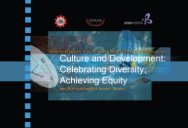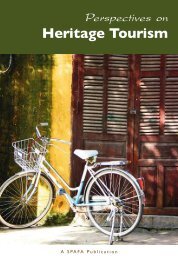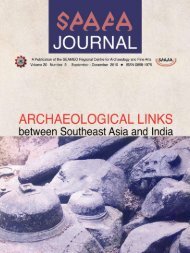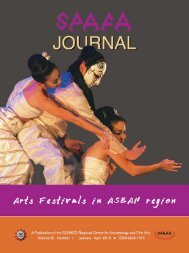Making Mangrove - Seameo-SPAFA
Making Mangrove - Seameo-SPAFA
Making Mangrove - Seameo-SPAFA
You also want an ePaper? Increase the reach of your titles
YUMPU automatically turns print PDFs into web optimized ePapers that Google loves.
Nature Centres for WetlandConservation in MalaysiaNoor Azlin Yahya,Chong Mew lm and Azyyati Abd. KadirIt was explained by the presenters that environmentalinterpretation serves as a very important management toolto convey the message for sustainable forest management,for example, in the form Recreation Forests. Moreover,wetland tourism, consisting of village communities;tourism with an emphasis on education; fireflies, birds,and other wildlife watching; and floating restaurants, hasalso received growing attention.The Forest Research Institute in Malaysia (FRIM)receives various types of visitors. Members of the generalpublic constitute 70 per cent of its visitors, while 24 percent are students and 6 per cent are foreign tourists.All through its history, trees have been annually planted,and it has surveyed the number planted between 1927and 1960.Today, FRIM operates within forested grounds,explained the presenters. It has established enoughto support the different types of habitat required by adiversity of wildlife, including the wetland dependentamphibians, such as tree frogs that need specific nichesas their dwellings near the tree canopies.In the “River Corridor” (Sg Kroh in FRIM), variousspecies of flora can be found, including the Jelutong(Dyera constulata), Sentang (Azadirachta excelsa), andTeak (Tectona grandis).Wetland Interpretation activities also involveclass outings from schools. Birds spotted during theseInterpretation activities include kingfishers, GoldwhiskeredBarbets, Crested Serpent Eagles, GreaterRacket-tailed drongo, and yellow Bitterns. Moreover,there are Monitor Lizards (Varabus sp), insects andwetland plants in adaptation.Another type of activity is the Nature InterpretationCamp, for which the theme “Treasures of Wetland”has been adopted. The activity is undertaken with anInterpretation Kit that is used to conduct an environmentaleducation programme relating to freshwater wetland.The presenters underscored that still many othertypes of activities are already in existence, such as Naturegames, Traditional games, and arts and crafts includingorigami.120 <strong>Making</strong> <strong>Mangrove</strong> Eco-Museums<strong>Making</strong> <strong>Mangrove</strong> Eco-Museums 121



